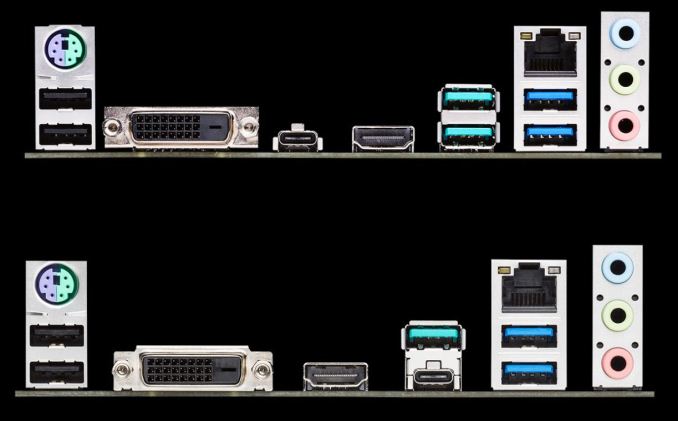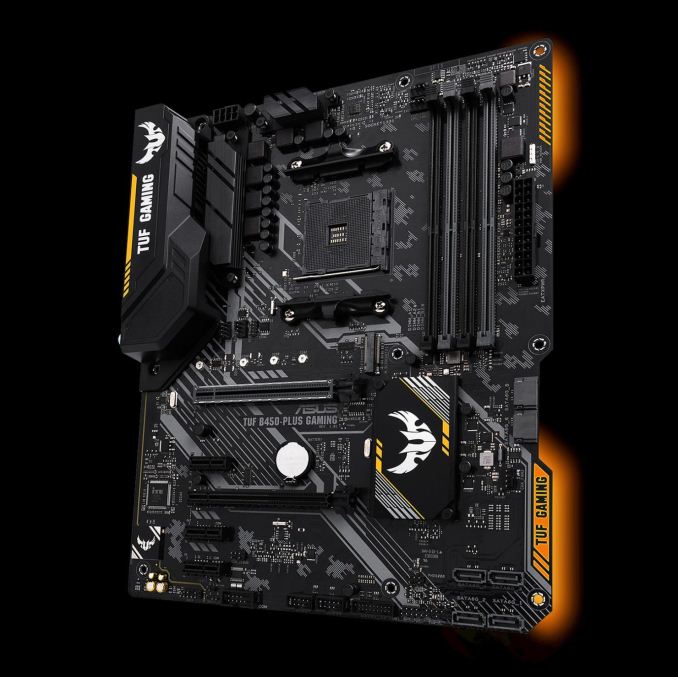Analyzing B450 for AMD Ryzen: A Quick Look at 25+ Motherboards
by Gavin Bonshor on July 31, 2018 8:00 AM ESTASUS TUF B450-Plus Gaming and
ASUS TUF B450M-Plus Gaming
Back in October last year, I went to an ASUS meeting at the UK HQ to talk about the upcoming Intel Z370 Motherboard launch where I was introduced to the ASUS TUF Z370-Pro Gaming and Z370-Plus Gaming. The TUF branding from ASUS is synonymous with boards such as the ASUS TUF X99 Sabertooth, so when ASUS HQ officials explained to me that the TUF (The Ultimate Force) brand was being re-arranged from a range with rugged looksand a longer than usual five year warranty to a more budget-focused gaming range which sits below the Strix range, it was somewhat nauseating. Nonetheless, ASUS states that they feel this is the best way forward for the brand, along with collaborations with memory and cooling manufacturers to be part of the TUF system.
With the launch of the new B450 chipset, ASUS has let loose two new TUF Gaming branded boards through the full-sized ATX TUF B450-Plus and the smaller TUF B450M-Plus.

The ASUS TUF B450M-Plus (left) and ASUS TUF B450-Plus (right) motherboards
Aesthetically speaking, both TUF B450 models have a near identical style with a customizable RGB section at the bottom right-hand corner, with both boards having a TUF branded chipset heatsink, dark grey metallic power delivery heatsinks and a rear panel cover which is black. The PCB also has a black and grey contrasting design printed on and the heatsinks have a yellow accented style which falls in line with the new TUF color scheme.
Both the TUF B450-Plus and B450M-Plus have very similar feature sets and component choices, with the main differences between the two coming through the form factor, which then naturally limits the PCIe 3.0 x1 capabilities of the B450M-Plus due to conforming to microATX standards. What both boards do share is two full-length PCIe slots with the top slot operating at PCIe 3.0 x16 and the second full-length slot operating at PCIe 2.0 x4 across both boards. The B450-Plus has a total of three PCIe 2.0 x1 slots, whereas the TUF B450M-Plus has a solitary x1 slot available.
Focusing on the power, ASUS looks to have equipped the same six phase Digi+ power delivery across both models, with the phases operating in 4+2 mode. Both boards have a metallic looking heatsink across the CPU section of the power delivery, while the SoC section does not. Power to the CPU comes from an 8-pin ATX 12 V input and power to the rest of the motherboard and chipset comes through a 24-pin ATX power input.
Both the TUF B450-Plus and B450M-Plus share the same storage options which primarily consists of six SATA ports with both models having four straight angled connectors, and two right-angled connectors emanating from the board. Users looking to make use of RAID storage configurations will be pleased to know both boards can accommodate RAID 0, 1 and 10 arrays. There is also a single PCIe 3.0 x4 M.2 slot featured on both models with support for drives up to a size of M.2 22110 (22 x 110 mm) and allows for both PCIe and SATA varieties of SSD to be used.
With the latest AM4 chipsets offering better memory capabilities out of the box thanks to a wave of firmware updates, both the TUF B450 boards take advantage of DDR4-3200 support from the get-go, with both having four memory slots giving the pairing a total combined memory capacity of up to 64 GB. The TUF boards also support ECC memory, but ASUS does state this support varies depending on the CPU.
In terms of cooling options, the ATX sized TUF B450-Plus has a total of five 4-pin fan headers dotted around the board which are split between one header to the CPU fan, three specifically for case fans and a single header dedicated to an AIO CPU cooler pump. The size limitation strikes the smaller microATX TUF B450M-Plus as only three 4-pin headers are present with a single one for the CPU fan and two for case fans. Both boards can have their USB real estate capabilities pushed beyond what’s on the rear panel with a further two USB 3.1 5 Gbps and four USB 2.0 ports being available through internal USB headers.

The ASUS TUF B450-Plus rear panel (top) compared to the ASUS TUF B450-M Plus rear panel (bottom)
Directing the attention to the rear panel, both boards have near indistinguishable layouts and connection choice with both boards having a PS/2 keyboard and mouse combo port, a single DVI-D and HDMI port, three 3.5mm audio jacks to make use of the Realtek ALC887-VD2 audio codec. On top of this is a single LAN port which is controlled by a Realtek RTL8111H Gigabit networking chip. The only differences come through the USB connections with the TUF B450-Plus having two USB 3.1 10 Gbps Type-A ports, a single USB 3.1 5 Gbps Type-C, two USB 3.1 5 Gbps Type-A ports and two regular USB 2.0 ports. The smaller ASUS TUF B450M-Plus has a single USB 3.1 10 Gbps Type-A port, a single USB 3.1 5 Gbps Type-C port, two USB 3.1 5 Gbps Type-A ports and two standard USB 2.0 ports.
Both of the TUF B450 Plus models have a unique styling with the black and white contrasting PCB, with yellow accents across the board and there is RGB expansion capability through a single ASUS Aura Sync-enabled RGB header on both for users looking to add their own flair and style. Both boards are near identical in features and with the B450-Plus Gaming set to retail for $119.99 and the smaller B450M-Plus Gaming coming in at a slightly cheaper price of $99.99, both look to offer value to users without scrimping too much on feature set.



_thumb.jpg)
_thumb.jpg)
_thumb.jpg)
_thumb.jpg)
_thumb.jpg)
_thumb.jpg)
_thumb.jpg)
_thumb.jpg)
_thumb.jpg)
_thumb.jpg)
_thumb.jpg)
_thumb.jpg)








62 Comments
View All Comments
tonecas1 - Tuesday, October 30, 2018 - link
Asus Prime 450M-K has only 4 Sata ports, audio is Realtek’s ALC887 only, and memory support goes to 3466 (OC)tonecas1 - Tuesday, October 30, 2018 - link
Asus Prime 450M-K has 2 PCIe 2.0x1 and 1 PCIe 3.0 x16 by CPU supporttonecas1 - Tuesday, October 30, 2018 - link
MSI B450M Pro-M2 only supports 2x DIMM slotstonecas1 - Wednesday, October 31, 2018 - link
ASRock B450M Pro4 is not a 6+3 power system but a 3+3. You have to remove the heat sink to see the MOSFET Hi and Lo combos and IC controlersQuarterPunder - Tuesday, March 5, 2019 - link
So if i buy this motherboard do i still need to buy a wifi card/Bluetooth receptor???msroadkill612 - Wednesday, March 20, 2019 - link
"Strix B450-F Gaming ..... Also present is a duo of M.2 slots with both having support for PCIe 3.0 x4 M.2 drives, while the top slot which supports both PCIe and SATA drives up to a size of M.2 2280 (22 x 80 mm), the bottom slot only supports PCIe 3.0 x4 drives with a sizing up to M.2 22110 (22 x 110 mm)."ALARMINGLY WRONG!
Newegg:
"AMD Ryzen 2nd Generation / Ryzen 1st Generation Processors: *
1 x M.2 Socket 3, with M key, type 2242/2260/2280 storage devices support (SATA & PCIE 3.0 x4 mode)**
1 x M.2 Socket 3, with M key, type 2242/2260/2280/22110 storage devices support (PCIE 3.0 x4 mode)***"
msroadkill612 - Wednesday, March 20, 2019 - link
edit - to remove any doubt - in full, the specs are:"AMD Ryzen 2nd Generation / Ryzen 1st Generation Processors: *
1 x M.2 Socket 3, with M key, type 2242/2260/2280 storage devices support (SATA & PCIE 3.0 x4 mode)**
1 x M.2 Socket 3, with M key, type 2242/2260/2280/22110 storage devices support (PCIE 3.0 x4 mode)***
AMD Ryzen with Radeon Vega Graphics Processor: *
1 x M.2 Socket 3, with M key, type 2242/2260/2280 storage devices support (SATA & PCIE 3.0 x4 mode)**
* Support StoreMI and NVMe RAID.
** When the M.2_1 Socket 3 is operating in SATA or PCIE mode, SATA6G_5/6 ports will be disabled.
*** When the M.2_2 is occupied by M.2 device, PCIe x16_1 will run at x8 mode."
g0rnex - Sunday, June 23, 2019 - link
I run windows from external SSD so I need fast USB ports for it to run smooth. Can I replace the USB ports by 3.2 gen2 when needed?g0rnex - Sunday, June 23, 2019 - link
I run win10 from an external SSD. for that I need a fast USB connection for windows to run smooth.Would it be possible to change the USB ports in the future? OR even now already by a 3.2 gen2. Or wouldn't replacing the ports speed up my connection with the external SSD?
Also I would like a good bluetooth connection. Do I need to use an adapter?
looking into making this build:
https://pcpartpicker.com/guide/hXzKHx/entry-level-...
GayCock69 - Monday, August 19, 2019 - link
ryzen 3700x + aorus pro wifi b450 + radeon rx5700xt, will it work optimally?